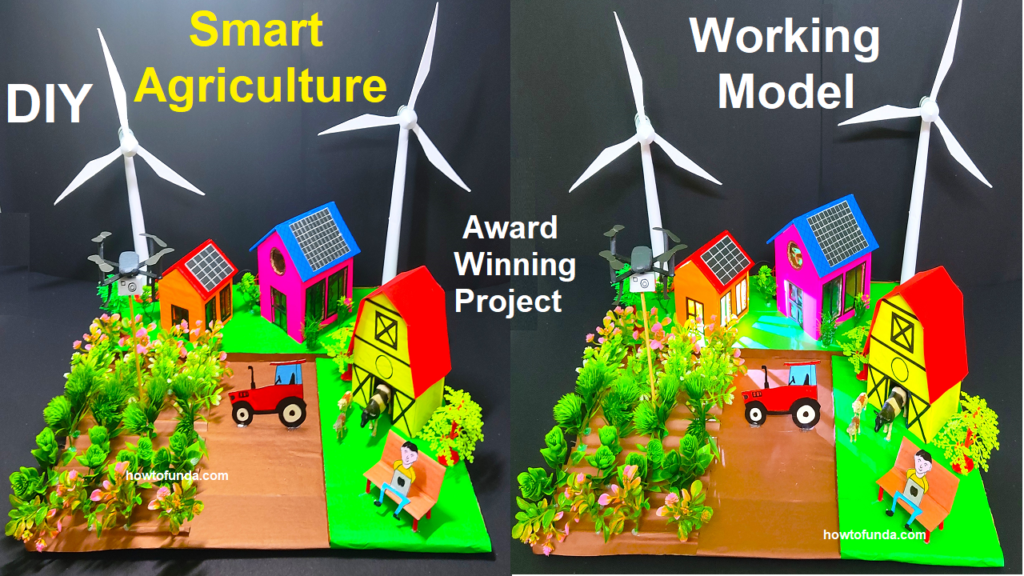Creating a comprehensive smart agriculture model integrating solar power, wind turbines, drones, tractors, and remote sensing involves combining various components to simulate advanced farming practices.

Below is a guide for building such a model:
Materials Needed:
- Cardboard or foam board (base for the model)
- Miniature solar panels
- Miniature wind turbine or DIY wind turbine model
- Miniature drone (toy drone or construct a simple model)
- Toy tractor or construct a simple model
- Small cameras (for drones)
- Small sensors (for remote sensing via mobile or laptop)
- LED lights or small bulbs
- Small motor (for wind turbine simulation)
- Small screens or displays (for data visualization)
- Modeling clay or small containers for soil representation
- Artificial plants or miniature plants
- Markers, paints, or other decorative materials
Video step by step instructions:
1. Prepare the Base:
- Use cardboard or foam board as the base for your model. This will represent the agricultural field.
2. Integrate Solar Panels:
- Place miniature solar panels on the model to represent solar power. Connect them to the Arduino or Raspberry Pi for power.
3. Install Wind Turbine:
- Install a miniature wind turbine or create a DIY wind turbine model. Connect a small motor to simulate rotation when wind is applied.
4. Integrate Drone:
- Place a miniature drone or construct a simple model on the model. Attach small cameras to represent drone imaging capabilities.
5. Add Tractor:
- Include a toy tractor or construct a simple model of a tractor on the model. Connect it to the Arduino or Raspberry Pi for control.
6. Integrate Sensors for Remote Sensing:
- Attach small sensors on the model to represent remote sensing devices. Connect these sensors to the Arduino or Raspberry Pi.
7. Connect Components to Microcontroller:
- Use jumper wires to connect the various components (solar panels, wind turbine, drone, tractor, sensors) to the Arduino or Raspberry Pi.
8. Program the Microcontroller:
- Program the microcontroller to control the various components, read data from sensors, and simulate smart agriculture practices.
9. Data Visualization:
- Connect small screens or displays to the microcontroller for data visualization. This can represent the data collected by sensors and drones.
10. Soil Representation:
- Use modeling clay or small containers to represent soil beds. Place artificial plants or miniature plants to simulate crops.
11. Decoration:
- Decorate the model with markers, paints, or other materials to make it visually appealing and resemble a farm setting.
12. Labeling:
- Label the different components of the model, such as solar panels, wind turbine, drone, tractor, and sensors.
13. Presentation:
- During your presentation, explain how each component contributes to smart agriculture practices, how data is collected and analyzed, and how automation is achieved.
Presentation Ideas:
- Explain Smart Agriculture Technologies:
- Provide an overview of smart agriculture technologies, including solar power, wind energy, drones, tractors, and remote sensing.
- Demonstrate Automation:
- Showcase how the model uses automation to simulate smart farming practices, such as automated drone surveillance and tractor control.
- Discuss Data Collection and Analysis:
- Emphasize how sensors and drones collect data, and how the microcontroller processes and visualizes this information.
- Highlight Sustainability:
- Discuss how the integration of renewable energy sources like solar and wind contributes to sustainable farming.
- Interactive Session:
- Allow your audience to interact with the model, controlling components, and observing data visualizations to enhance understanding.

